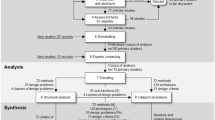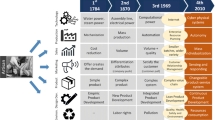Abstract
The realization that designing products in families can and does have significant technological and economic advantages over traditional single product design has motivated increasing interest in recent years in formal design tools and methodologies for product family design. However, currently there is no guidance for designers in the first key strategic decisions of product family design, in particular determining the type of product family to design. Hence, in this paper, first a taxonomy of different types of product families is presented which consists of seven types of product families, categorized based on number of products and time of product introduction. Next a methodology is introduced to support designers in deciding which type of product family is appropriate, based upon early knowledge about the nature of the intended product(s) and their intended market(s). From this information it follows both which manufacturing paradigm and which fundamental design strategies are appropriate for each type of product family. Finally, the proposed methodology is illustrated through a case study examining a family of whitewater kayaks.
Similar content being viewed by others
References
Anderson D.M., Pine B.J. II (1997). Agile product development for mass customization. Chicago, Irwin
Baldwin C.Y., Clark K.B. (2000). Design rules: The power of modularity. Cambridge, MA: MIT Press
Bremmer, R. (1999). Cutting-edge platforms. Financial Times Automotive World, September 1999, 30–38
Chase A. (1997). Law and history: The evolution of the American legal system. New York, The New Press
de Lit P., Delchambre A., Henrioud J.M. (2003). An integrated approach for product family and assembly system design. IEEE Transactions on Robotics and Automation 19(2): 324–335
Fujita, K., & Ishii, K. (1997). Task structuring toward computational approaches to product family design. Sacramento, CA: ASME DETC/DAC.
Gupta S., Krishnan V. (1998). Product family-based assembly sequence design methodology. IIE Transactions 30, 933–945
Ishii, K., Juengel, C. et al. (1995). Design for product variety: Key to product line structuring. ASME DETC.
Maier, J. R. A. (2000). Strategic decisions in the early stages of product family design. Master’s Thesis, Department of Mechanical Engineering, Clemson University.
Maier J.R.A., Fadel G.M. (2006). Understanding the complexity of design. In: Braha D., Minai A.A., Bar-Yam Y.(eds) Complex engineering systems: Science Meets Technology. New York, Springer
Martin, M. V., & Ishii, K. (1996). Design for variety: A methodology for understanding the costs of product proliferation. ASME design engineering technical conferences – design theory & methodology conference. Irvine, CA: ASME, Paper No. 96-DETC/DTM-1610.
Meyer M.H., Lehnerd A.P. (1997). The power of product platforms: Building value and cost leadership. New York, Free Press
Mistree F., Bras B.A., Smith W.F., Allen J.K. (1996). Modeling design processes: A conceptual, decision-based perspective. Engineering Design and Automation 1(4): 209–221
Mowery D.C. (2003). Fifty years of business computing: LEO to linux. The Journal of Strategic Information Systems 12(4): 295–308
O’Grady P. (1999). The age of modularity. Iowa City, Adams and Steele
Pahl G., Beitz W. (1996). Engineering design: A systematic approach (2nd edn). New York, Springer-Verlag
Pugh S. (1990). Total design: Integrated methods for successful product engineering. New York, Addison-Wesley
Sabbagh K. (1996). Twenty-first century jet: The making and marketing of the boeing 777. New York, Scribner
Sanderson S.W., Uzumeri M. (1997). Managing product families. Chicago, Irwin
Simpson, T. W. (2003). Product platform design and optimization: Status and promise. ASME design engineering technical conferences – design automation conference. Chicago, IL: ASME, Paper No. DETC2003/DAC-48717.
Simpson T.W., Maier J.R.A., Mistree F. (2001). Product platform design: Method and application. Research in Engineering Design, 13(1): 2–22
Sekolec, R., Kunz, A., & Meier, M. (2003). Methodology for product structuring in the early stages of the design process. Proceedings of the international conference on engineering design, ICED ’03, Stockholm, Sweden, August 19–21, 2003.
Sparke P. (2002). A century of car design. New York, Barrons Educational Series
Stone R.B., Wood K.L., Crawford R.H. (2000). Using quantitative functional models to develop product architectures. Design Studies 21(3): 239–260
Subrahmanyam S.R. (2002). A method for generation of machining and fixturing features from design features. Computers in Industry 47(3): 269–287
Suzaki K. (1987). The new manufacturing challenge: Techniques for continuous improvement. New York, Free Press
Ulrich K.T., Eppinger S.D. (2000). Product design and development (2nd edn). New York, McGraw-Hill
Wheelwright S.C., Sasser W.E. Jr. (1989). The new product development map. Harvard Business Review 67, 112–125
Womack J.P., Jones D.T., Roos. D. (1990). The machine that changed the world: The story of lean production. New York, Harper-Perennial
Zamirowski, E. J., & Otto, K. N. (1999). Identifying product portfolio architecture modularity using function and variety heuristics. ASME design engineering technical conferences – design theory & methodology conference. Las Vegas, NV: ASME, Paper No. DETC99/DTM-8760.
Author information
Authors and Affiliations
Corresponding author
Rights and permissions
About this article
Cite this article
Maier, J.R.A., Fadel, G.M. A taxonomy and decision support for the design and manufacture of types of product families. J Intell Manuf 18, 31–45 (2007). https://doi.org/10.1007/s10845-007-0002-3
Received:
Accepted:
Published:
Issue Date:
DOI: https://doi.org/10.1007/s10845-007-0002-3




